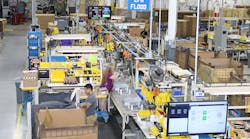Toyoda Gosei Co., Ltd, one of the world's leading LED manufacturers, has surprised the community by issuing a press release advising "the fullest caution to avoid infringement" of its patents on GaN-based LEDs.
Toyoda's rivals including Nichia and Osram Opto Semiconductors have been active in recent years in pursuing companies which they believe infringe their patents, and have also publicly announced licensing agreements for their technology (see Patents Channel - Blue and White LEDs). However, Toyoda has kept relatively quiet, despite owning a patent portfolio which is second to none and arguably forms the basis for the entire GaN-based LED industry.
Toyoda has signed two major agreements with its rivals; an agreement with Nichia dating back to September 2002 (Nichia and Toyoda Gosei settle their differences), and a more recent agreement with Philips Lumileds signed in April 2006 (Toyoda Gosei and Lumileds sign patent agreement). Toyoda says that these separate agreements allow the parties to utilize each other’s LED-related patents, and also says that it licenses the use of particular LEDs as defined in individual agreements.
The Toyoda press release goes on to say that "because the manufacture, sale, or use of GaN-based semiconductor LEDs by any entity other than these may constitute infringement of Toyoda Gosei’s patents, Toyoda Gosei advises the fullest caution to avoid infringement." The company says it has filed more than 2,000 patent applications related to GaN-based semiconductor LEDs, and has acquired patent rights on some 600 of these.
According to its own information, Toyoda Gosei started development of GaN-based blue LEDs in 1986 under the guidance of Dr. Isamu Akasaki of Nagoya University and with assistance from Toyota Central R&D Labs. In 1987, the project group was commissioned by the Research Development Corporation of Japan (JRDC) to conduct "development of blue LED manufacturing technologies". The project received JRDC’s designation of successful completion in 1991. In October 1995, Toyoda Gosei started mass production of high-brilliance blue LEDs (although this was two years after Nichia).
Details of the agreement between Nichia and Toyoda have never been made public, but there is a strong indication that Toyoda emerged in by far the strongest position, given that it had won almost all the court cases between the two companies prior to the settlement date. One suggestion is that Toyoda has the right to use Nichia's GaN-based LED patents up until the settlement date, but that the reverse is not true.
White LED-related patents
Toyoda's press release also discusses the phosphor technology patented by Toyoda in partnership with Tridonic Optoelectronics GmbH (Austria), Leuchtstoffwerk Breitungen GmbH (Germany), and Litec GbR (Germany).
The patents cover basic technology for using blue LEDs in combination with silicate phosphors.Patent rights have been granted in Austria, the USA (patents #6,809,347 and #6,943,380), Korea, Taiwan and Russia, and China will be soon added to the list.
Toyoda says that it has roughly twenty licensees for these patents worldwide, but it now believes that companies other than licensees have been manufacturing and selling white LEDs using silicate phosphors. Again, the company is advising "the fullest caution" to avoid any infringement that might be taking place.
Patent dispute settled
In related news, a claim by a Columbia University professor of patent infringement by Toyoda Gosei has been settled. Professor Gertrude Neumark claimed last year that Toyoda was infringing her US patents #4,904,618 and #5,252,499, but has now "granted rights" under these patents to Toyoda.
Toyoda previously rubbished the professor's claims, and it is difficult to see how the patents could relate to commercial production of GaN-based LEDs. Since details of the settlement are not available, we conclude that it is extremely unlikely that money changed hands and there is no suggestion that Toyoda has in any way licensed the technology. Even so, Professor Neumark has launched similar claims against Cree, Lumileds and Osram.




